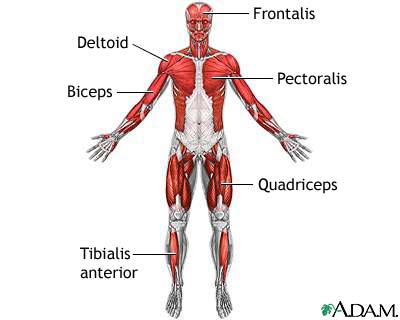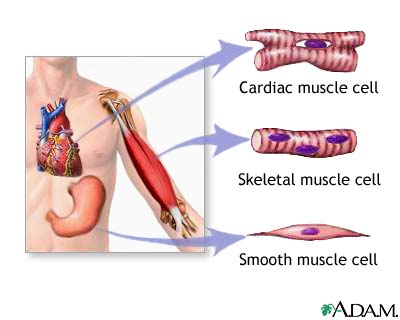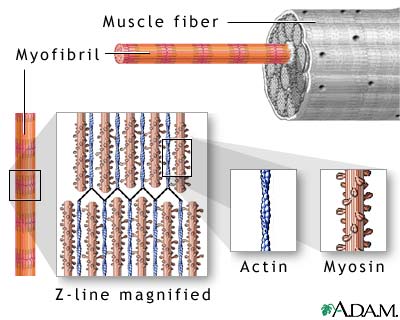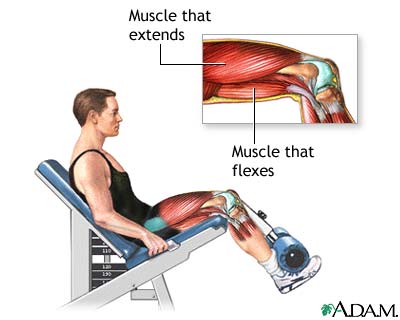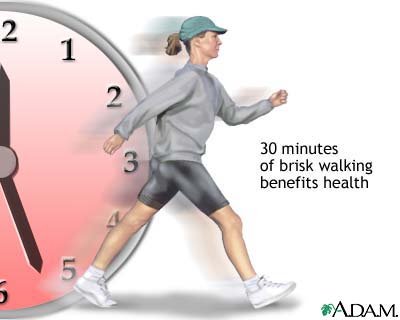|
|
|
|
|
Navigation links Over 600 skeletal muscles function for body movement through contraction and relaxation of voluntary, striated muscle fibers. These muscles are attached to bones, and are typically under conscious control for locomotion, facial expressions, posture, and other body movements. Muscles account for approximately 40 percent of body weight. The metabolism that occurs in this large mass-produces heat essential for the maintenance of body temperature.
Cardiac muscle is only in the heart and makes up the atria and ventricles (heart walls). Like skeletal muscle, cardiac muscle contains striated fibers. Cardiac muscle is called involuntary muscle because conscious thought does not control its contractions. Specialized cardiac muscle cells maintain a consistent heart rate. Smooth muscle is throughout the body, including in visceral (internal) organs, blood vessels, and glands. Like cardiac muscle, smooth muscle is involuntary. Unlike skeletal and cardiac muscle, smooth muscle is nonstriated (not banded). Smooth muscle, which is extensively within the walls of digestive tract organs, causes peristalsis (wave-like contractions) that aids in food digestion and transport. Except the heart, any action that the body performs without conscious thought is done by smooth muscle contractions. This includes diverse activities such as constricting (closing) the bronchioles (air passages) of the lungs or pupils of the eye or causing goosebumps in cold conditions. A skeletal muscle has regular, ordered groups of fascicles, muscle fibers, myofibrils, and myofilaments. Epimysium (thick connective tissue) binds groups of fascicles together. A fascicle has muscle fibers; perimysium (connective tissue) envelops the fascicle. Endomysium (connective tissue) surrounds the muscle fibers. A muscle fiber divides into even smaller parts. Within each fiber are strands of myofibrils. These long cylindrical structures appear striped due to strands of tiny myofilaments. Myofilaments have two types of protein: actin (thin myofilaments) and myosin (thick myofilaments).
The actin and myosin myofilaments align evenly, producing dark and light bands on the myofibril. Each dark band depicts an area where the myofilaments overlap, causing the striated appearance of skeletal muscle. All dark and light bands of the myofilaments have names. At the Z-line, actin strands interweave. The region between two Z-lines is a sarcomere, the functional unit of skeletal muscle. Muscle contraction occurs when overlapping actin and myosin myofilaments overlap further and shorten the muscle cell. The myofilaments keep their length. The overlapping of myofilaments is the basis for the sliding filament theory of contraction. Skeletal muscle is a system of pairs that relax and contract to move a joint. For example, when front leg muscles contract, the knee extends (straightens) while back leg muscles relax. Conversely, to flex (bend) the knee, back leg muscles contract while front leg muscles relax. Some muscles are named for their ability to extend or flex a joint; for example, extensor carpiradialis longus muscle and flexor digitorum brevis muscle.
Tendons attach most skeletal muscles to bones. Tendons are strong sheets of connective tissue that are identical with ligaments. Tendons and ligaments differ in function only: tendons attach muscle to bone and ligaments attach bone to bone. Physical exercise strengthens the attachment of tendons to bones. Skeletal muscles have muscle tone (remain partly contracted), which helps maintain body posture. Ongoing signals from the nervous system to the muscle cells help maintain tone and readiness for physical activity. Skeletal muscle aids in heat generation. During muscle contractions, muscle cells expend much energy, most of which is converted to heat. To prevent overheating, glands in the skin produce sweat to cool the skin; and, the body radiates heat from the blood and tissues through the skin. When the body is chilly, shivering causes quick muscle contractions that generate heat. Skeletal muscles have two types of muscle fibers: fast-twitch and slow-twitch. Anaerobic exercise uses fast-twitch fibers. Such exercise includes activities that are fleeting and require brief high-energy expenditure. Weightlifting, sprinting, and push-ups are examples of anaerobic exercise. Because all cells require oxygen to produce energy, anaerobic exercise depletes oxygen reserves in the muscle cells quickly. The result is an oxygen debt. To repay the debt, humans breathe deeply and rapidly, which restores the oxygen level. Anaerobic exercise creates excess lactic acid (a waste product). By increasing oxygen intake, the liver cells can convert the excess lactic acid into glucose, the primary food molecule used in cellular metabolism.
Aerobic exercise uses slow-twitch muscle fibers. Such exercise includes activities that are prolonged and require constant energy. Long distance running and cycling are examples of aerobic exercise. In aerobic exercise, the muscle cell requires the same amount of oxygen that the body supplies. The oxygen debt is slashed and lactic acid is not formed. |
Any duplication or distribution of the information contained herein is strictly prohibited. The information provided herein should not be used for diagnosis or treatment of any medical condition and is provided for your general information only.
